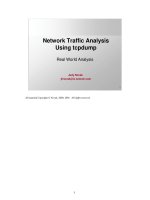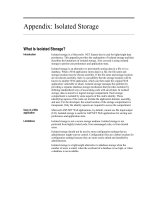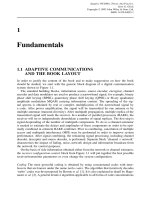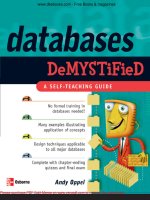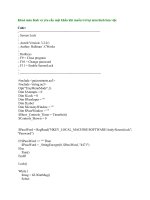Tài liệu Databases Demystified- P1 doc
Bạn đang xem bản rút gọn của tài liệu. Xem và tải ngay bản đầy đủ của tài liệu tại đây (1.28 MB, 50 trang )
www.dbebooks.com - Free Books & magazines
Please purchase PDF Split-Merge on www.verypdf.com to remove this watermark.
DATABASES DEMYSTIFIED
P:\010Comp\DeMYST\364-9\fm.vp
Tuesday, February 10, 2004 9:57:24 AM
Color profile: Generic CMYK printer profile
Composite Default screen
Please purchase PDF Split-Merge on www.verypdf.com to remove this watermark.
P:\010Comp\DeMYST\364-9\fm.vp
Tuesday, February 10, 2004 9:57:24 AM
Color profile: Generic CMYK printer profile
Composite Default screen
This page intentionally left blank.
Please purchase PDF Split-Merge on www.verypdf.com to remove this watermark.
DATABASES DEMYSTIFIED
ANDREW J. OPPEL
McGraw-Hill/Osborne
New York Chicago San Francisco Lisbon London
Madrid Mexico City Milan New Delhi San Juan
Seoul Singapore Sydney Toronto
P:\010Comp\DeMYST\364-9\fm.vp
Tuesday, February 10, 2004 9:57:24 AM
Color profile: Generic CMYK printer profile
Composite Default screen
Please purchase PDF Split-Merge on www.verypdf.com to remove this watermark.
P:\010Comp\DeMYST\364-9\fm.vp
Tuesday, February 10, 2004 9:57:24 AM
Color profile: Generic CMYK printer profile
Composite Default screen
Copyright © 2004 by The McGraw-Hill Companies. All rights reserved. Manufactured in the United States of
America. Except as permitted under the United States Copyright Act of 1976, no part of this publication may be
reproduced or distributed in any form or by any means, or stored in a database or retrieval system, without the
prior written permission of the publisher.
0-07-146960-5
The material in this eBook also appears in the print version of this title: 0-07-225364-9.
All trademarks are trademarks of their respective owners. Rather than put a trademark symbol after every
occurrence of a trademarked name, we use names in an editorial fashion only, and to the benefit of the
trademark owner, with no intention of infringement of the trademark. Where such designations appear in this
book, they have been printed with initial caps. McGraw-Hill eBooks are available at special quantity discounts
to use as premiums and sales promotions, or for use in corporate training programs. For more information,
please contact George Hoare, Special Sales, at or (212) 904-4069.
TERMS OF USE
This is a copyrighted work and The McGraw-Hill Companies, Inc. (“McGraw-Hill”) and its licensors reserve all
rights in and to the work. Use of this work is subject to these terms. Except as permitted under the Copyright
Act of 1976 and the right to store and retrieve one copy of the work, you may not decompile, disassemble,
reverse engineer, reproduce, modify, create derivative works based upon, transmit, distribute, disseminate, sell,
publish or sublicense the work or any part of it without McGraw-Hill’s prior consent. You may use the work for
your own noncommercial and personal use; any other use of the work is strictly prohibited. Your right to use the
work may be terminated if you fail to comply with these terms.
THE WORK IS PROVIDED “AS IS.” McGRAW-HILL AND ITS LICENSORS MAKE NO GUARANTEES
OR WARRANTIES AS TO THE ACCURACY, ADEQUACY OR COMPLETENESS OF OR RESULTS TO
BE OBTAINED FROM USING THE WORK, INCLUDING ANY INFORMATION THAT CAN BE
ACCESSED THROUGH THE WORK VIA HYPERLINK OR OTHERWISE, AND EXPRESSLY DISCLAIM
ANY WARRANTY, EXPRESS OR IMPLIED, INCLUDING BUT NOT LIMITED TO IMPLIED
WARRANTIES OF MERCHANTABILITY OR FITNESS FOR A PARTICULAR PURPOSE. McGraw-Hill
and its licensors do not warrant or guarantee that the functions contained in the work will meet your
requirements or that its operation will be uninterrupted or error free. Neither McGraw-Hill nor its licensors shall
be liable to you or anyone else for any inaccuracy, error or omission, regardless of cause, in the work or for any
damages resulting therefrom. McGraw-Hill has no responsibility for the content of any information accessed
through the work. Under no circumstances shall McGraw-Hill and/or its licensors be liable for any indirect,
incidental, special, punitive, consequential or similar damages that result from the use of or inability to use the
work, even if any of them has been advised of the possibility of such damages. This limitation of liability shall
apply to any claim or cause whatsoever whether such claim or cause arises in contract, tort or otherwise.
DOI: 10.1036/0071469605
Please purchase PDF Split-Merge on www.verypdf.com to remove this watermark.
To everyone from whom I have learned so
much about so many things, including the
many teachers, students, and co-workers
I have had the pleasure of knowing.
P:\010Comp\DeMYST\364-9\fm.vp
Tuesday, February 10, 2004 9:57:24 AM
Color profile: Generic CMYK printer profile
Composite Default screen
Please purchase PDF Split-Merge on www.verypdf.com to remove this watermark.
ABOUT THE AUTHOR
Andrew J. (Andy) Oppel is a proud graduate of The Boys’ Latin School of Mary-
land and of Transylvania University (Lexington, KY) where he earned a BA in com-
puter science in 1974. Since then he has been continuously employed in a wide
variety of information technology positions, including programmer, programmer/
analyst, systems architect, project manager, senior database administrator, database
group manager, consultant, database designer, and data architect. In addition, he has
been a part-time instructor with the University of California (Berkeley) Extension
for over 20 years, and received the Honored Instructor Award for the year 2000. His
teaching work has included developing two courses for UC Extension, “Concepts of
Database Management Systems” and “Introduction to Relational Database Man-
agement Systems.” He also earned his Oracle 9i Database Associate certification in
2003. He is currently employed as the principal data architect for Ceridian, a leading
provider of human resource solutions. Aside from computer systems, Andy enjoys
music (guitar and vocals), amateur radio (Pacific Division vice director, American
Radio Relay League), and soccer (referee instructor, U.S. Soccer).
Andy has designed and implemented hundreds of databases for a wide range of
applications, including medical research, banking, insurance, apparel manufactur
-
ing, telecommunications, wireless communications, and human resources. His da
-
tabase product experience includes IMS, DB2, Sybase, Microsoft SQL Server,
Microsoft Access, MySQL, and Oracle (versions 7, 8, 8i, and 9i).
P:\010Comp\DeMYST\364-9\fm.vp
Tuesday, February 10, 2004 9:57:24 AM
Color profile: Generic CMYK printer profile
Composite Default screen
Copyright © 2004 by The McGraw-Hill Companies. Click here for terms of use.
Please purchase PDF Split-Merge on www.verypdf.com to remove this watermark.
CONTENTS AT A GLANCE
CHAPTER 1 Database Fundamentals 1
CHAPTER 2 Exploring Relational Database Components 25
CHAPTER 3 Forms-Based Database Queries 51
CHAPTER 4 Introduction to SQL 89
CHAPTER 5 The Database Life Cycle 129
CHAPTER 6 Logical Database Design Using
Normalization 145
CHAPTER 7 Data and Process Modeling 179
CHAPTER 8 Physical Database Design 203
CHAPTER 9 Connecting Databases to the Outside World 227
CHAPTER 10 Database Security 247
CHAPTER 11 Database Implementation 273
CHAPTER 12 Databases for Online Analytical Processing 293
Final Exam 307
Answers to Quizzes and Final Exam 325
Index 329
vii
P:\010Comp\DeMYST\364-9\fm.vp
Tuesday, February 10, 2004 9:57:24 AM
Color profile: Generic CMYK printer profile
Composite Default screen
Please purchase PDF Split-Merge on www.verypdf.com to remove this watermark.
P:\010Comp\DeMYST\364-9\fm.vp
Tuesday, February 10, 2004 9:57:24 AM
Color profile: Generic CMYK printer profile
Composite Default screen
This page intentionally left blank.
Please purchase PDF Split-Merge on www.verypdf.com to remove this watermark.
CONTENTS
Acknowledgments xvii
Introduction xix
CHAPTER 1 Database Fundamentals 1
Properties of a Database 1
The Database Management System (DBMS) 2
Layers of Data Abstraction 3
Physical Data Independence 5
Logical Data Independence 6
Prevalent Database Models 7
Flat Files 7
The Hierarchical Model 9
The Network Model 11
The Relational Model 13
The Object-Oriented Model 15
The Object-Relational Model 16
A Brief History of Databases 17
Why Focus on Relational? 19
Quiz 20
CHAPTER 2 Exploring Relational Database Components 25
Conceptual Database Design Components 26
Entities 27
ix
P:\010Comp\DeMYST\364-9\fm.vp
Tuesday, February 10, 2004 9:57:24 AM
Color profile: Generic CMYK printer profile
Composite Default screen
For more information about this title, click here
Please purchase PDF Split-Merge on www.verypdf.com to remove this watermark.
x
Databases Demystified
Demystified / Databases Demystified / Oppel/ 225364-9 / FM
Attributes 27
Relationships 28
Business Rules 32
Logical/Physical Database Design Components 33
Tables 33
Columns and Data Types 34
Constraints 37
Integrity Constraints 42
Views 45
Quiz 46
CHAPTER 3 Forms-Based Database Queries 51
QBE: The Roots of Forms-Based Queries 52
Getting Started in Microsoft Access 52
The Microsoft Access Relationships Panel 55
The Microsoft Access Table Design View 57
Creating Queries in Microsoft Access 59
Example 3-1: List All Customers 62
Example 3-2: Choosing Columns to Display 63
Example 3-3: Sorting Results 64
Example 3-4: Advanced Sorting 66
Example 3-5: Choosing Rows to Display 66
Example 3-6: Compound Row Selection 68
Example 3-7: Using Not Equal 70
Example 3-8: Joining Tables 70
Example 3-9: Limiting Join Results 72
Example 3-10: Outer Joins 75
Example 3-11: Multiple Joins;
Calculated Columns 77
Example 3-12: Aggregate Functions 80
Example 3-13: Self-Joins 82
Quiz 85
P:\010Comp\DeMYST\364-9\fm.vp
Tuesday, February 10, 2004 9:57:24 AM
Color profile: Generic CMYK printer profile
Composite Default screen
Please purchase PDF Split-Merge on www.verypdf.com to remove this watermark.
Demystified / Databases Demystified / Oppel/ 225364-9 / FM
CHAPTER 4 Introduction to SQL 89
The History of SQL 90
Getting Started with Oracle SQL 91
Where’s the Data? 96
Finding Database Objects Using Catalog Views 97
Viewing Database Objects Using
Oracle Enterprise Manager 98
Data Query Language (DQL):
The SELECT Statement 100
Example 4-1: Listing All Employees 100
Example 4-2: Limiting Columns to Display 100
Example 4-3: Sorting Results 102
Choosing Rows to Display 103
Joining Tables 108
Aggregate Functions 112
Data Manipulation Language (DML) 114
Transaction Support
(COMMIT and ROLLBACK) 114
The INSERT Statement 115
The UPDATE Statement 116
The DELETE Statement 117
Data Definition Language (DDL) Statements 118
The CREATE TABLE Statement 118
The ALTER TABLE Statement 119
The CREATE VIEW Statement 121
The CREATE INDEX Statement 121
The DROP Statement 122
Data Control Language (DCL) Statements 122
The GRANT Statement 123
The REVOKE Statement 123
Quiz 124
CONTENTS
xi
P:\010Comp\DeMYST\364-9\fm.vp
Tuesday, February 10, 2004 9:57:24 AM
Color profile: Generic CMYK printer profile
Composite Default screen
Please purchase PDF Split-Merge on www.verypdf.com to remove this watermark.
xii
Databases Demystified
Demystified / Databases Demystified / Oppel/ 225364-9 / FM
CHAPTER 5 The Database Life Cycle 129
The Traditional Method 130
Planning 130
Requirements Gathering 132
Conceptual Design 135
Logical Design 136
Physical Design 136
Construction 137
Implementation and Rollout 138
Ongoing Support 138
Nontraditional Methods 139
Prototyping 139
Rapid Application Development (RAD) 140
Quiz 141
CHAPTER 6 Logical Database Design Using
Normalization 145
The Need for Normalization 147
Insert Anomaly 148
Delete Anomaly 148
Update Anomaly 148
Applying the Normalization Process 148
Choosing a Primary Key 151
First Normal Form: Eliminating
Repeating Data 153
Second Normal Form: Eliminating
Partial Dependencies 156
Third Normal Form: Eliminating
Transitive Dependencies 158
Beyond Third Normal Form 160
Denormalization 163
Practice Problems 164
TLA University Academic Tracking 164
P:\010Comp\DeMYST\364-9\fm.vp
Tuesday, February 10, 2004 9:57:24 AM
Color profile: Generic CMYK printer profile
Composite Default screen
Please purchase PDF Split-Merge on www.verypdf.com to remove this watermark.
Computer Books Company 170
Quiz 174
CHAPTER 7 Data and Process Modeling 179
Entity Relationship Modeling 180
ERD Formats 180
Super Types and Subtypes 184
Guidelines for Drawing ERDs 188
Process Models 189
The Flowchart 190
The Function Hierarchy Diagram 192
The Swim Lane Diagram 193
The Data Flow Diagram 194
Relating Entities and Processes 196
Quiz 198
CHAPTER 8 Physical Database Design 203
Designing Tables 204
Implementing Super Types and Subtypes 208
Naming Conventions 211
Integrating Business Rules and Data Integrity 214
NOT NULL Constraints 216
Primary Key Constraints 216
Referential (Foreign Key) Constraints 216
Unique Constraints 217
Check Constraints 218
Data Types, Precision, and Scale 218
Triggers 219
Designing Views 220
Adding Indexes for Performance 221
Quiz 222
CHAPTER 9 Connecting Databases to the Outside World 227
Deployment Models 228
Centralized Model 228
CONTENTS
xiii
P:\010Comp\DeMYST\364-9\fm.vp
Tuesday, February 10, 2004 9:57:24 AM
Color profile: Generic CMYK printer profile
Composite Default screen
Please purchase PDF Split-Merge on www.verypdf.com to remove this watermark.
xiv
Databases Demystified
Demystified / Databases Demystified / Oppel/ 225364-9 / FM
Distributed Model 229
Client/Server Model 231
Connecting Databases to the Web 235
Introduction to the Internet and the Web 236
Components of the Web “Technology Stack” 238
Invoking Transactions from Web Pages 239
Connecting Databases to Applications 240
Connecting Databases via ODBC 240
Connecting Databases to Java Applications 241
Quiz 242
CHAPTER 10 Database Security 247
Why Is Security Necessary? 247
Database Server Security 249
Physical Security 249
Network Security 250
System-Level Security 255
Database Client and Application Security 255
Login Credentials 256
Data Encryption 256
Other Client Considerations 257
Database Access Security 258
Database Security Architectures 259
Schema Owner Accounts 263
System Privileges 264
Object Privileges 265
Roles 265
Views 266
Security Monitoring and Auditing 267
Quiz 268
CHAPTER 11 Database Implementation 273
Cursor Processing 273
P:\010Comp\DeMYST\364-9\fm.vp
Tuesday, February 10, 2004 9:57:24 AM
Color profile: Generic CMYK printer profile
Composite Default screen
Please purchase PDF Split-Merge on www.verypdf.com to remove this watermark.
Transaction Management 276
What Is a Transaction? 276
DBMS Support for Transactions 276
Locking and Transaction Deadlock 278
Performance Tuning 283
Tuning Database Queries 284
Tuning DML Statements 286
Change Control 287
Quiz 288
CHAPTER 12 Databases for Online Analytical Processing 293
Data Warehouses 294
OLTP Systems Compared
with Data Warehouse Systems 295
Data Warehouse Architecture 296
Data Marts 301
Data Mining 302
Quiz 303
Final Exam 307
Answers to Quizzes and Final Exam 325
Chapter 1 325
Chapter 2 325
Chapter 3 326
Chapter 4 326
Chapter 5 326
Chapter 6 326
Chapter 7 326
Chapter 8 327
Chapter 9 327
Chapter 10 327
Chapter 11 327
Chapter 12 327
Index 329
CONTENTS
xv
P:\010Comp\DeMYST\364-9\fm.vp
Tuesday, February 10, 2004 9:57:24 AM
Color profile: Generic CMYK printer profile
Composite Default screen
Please purchase PDF Split-Merge on www.verypdf.com to remove this watermark.
P:\010Comp\DeMYST\364-9\fm.vp
Tuesday, February 10, 2004 9:57:24 AM
Color profile: Generic CMYK printer profile
Composite Default screen
This page intentionally left blank.
Please purchase PDF Split-Merge on www.verypdf.com to remove this watermark.
ACKNOWLEDGMENTS
I owe much to my parents for providing me with an excellent education and a love of
both learning and teaching. I credit The Boys’ Latin School of Maryland and the late
Jack H. Williams, headmaster, with teaching me to write effectively. And I credit
Transylvania University and Dr. James E. Miller for introducing me to the fascinating
world of information systems and providing me with the tools for continuous learning.
I’d like to thank the wonderful people at McGraw-Hill/Osborne for the opportunity to
write my first book and for their excellent support during the writing process. Finally,
my thanks to my wife Laurie and our sons Keith and Luke for their support, patience,
and understanding during the long hours it took to produce this book.
xvii
P:\010Comp\DeMYST\364-9\fm.vp
Tuesday, February 10, 2004 9:57:25 AM
Color profile: Generic CMYK printer profile
Composite Default screen
Copyright © 2004 by The McGraw-Hill Companies. Click here for terms of use.
Please purchase PDF Split-Merge on www.verypdf.com to remove this watermark.
P:\010Comp\DeMYST\364-9\fm.vp
Tuesday, February 10, 2004 9:57:25 AM
Color profile: Generic CMYK printer profile
Composite Default screen
This page intentionally left blank.
Please purchase PDF Split-Merge on www.verypdf.com to remove this watermark.
INTRODUCTION
Thirty years ago, databases were found only in special research laboratories where
computer scientists struggled with ways to make them efficient and useful, and pub-
lished their findings in countless research papers. Today databases are a ubiquitous
part of the information technology (IT) industry and business in general. We directly
and indirectly use databases every day—banking transactions, travel reservations,
employment relationships, web site searches, purchases, and most other transac-
tions are recorded in and served by databases.
As with many fast-growing technologies, industry standards have lagged behind
the development of database technology, resulting in a myriad of commercial prod-
ucts, each following a particular software vendor’s vision. Moreover, a number of
different database models have emerged, with the relational model being the most
prevalent. Databases Demystified examines all of the major database models, in
-
cluding hierarchical, network, relational, object-oriented, and object-relational.
However, Databases Demystified concentrates heavily upon the relational and ob
-
ject-relational models because these are the mainstream of the IT industry and will
likely remain so in the foreseeable future.
The most significant challenge in implementing a database is designing the struc
-
ture of the database correctly. Without a thorough understanding of the problem the
database is intended to solve, and without knowledge of the best practices for orga
-
nizing the required data, the implemented database becomes an unwieldy beast that
requires constant attention. Databases Demystified focuses on transformation of re
-
quirements into a working database model with special emphasis on a process called
normalization, which has proven to be an effective technique for designing rela
-
tional databases. In fact, normalization can be applied successfully to other database
models. And, in keeping with the notion that you cannot design an automobile if you
xix
P:\010Comp\DeMYST\364-9\fm.vp
Tuesday, February 10, 2004 9:57:25 AM
Color profile: Generic CMYK printer profile
Composite Default screen
Copyright © 2004 by The McGraw-Hill Companies. Click here for terms of use.
Please purchase PDF Split-Merge on www.verypdf.com to remove this watermark.

